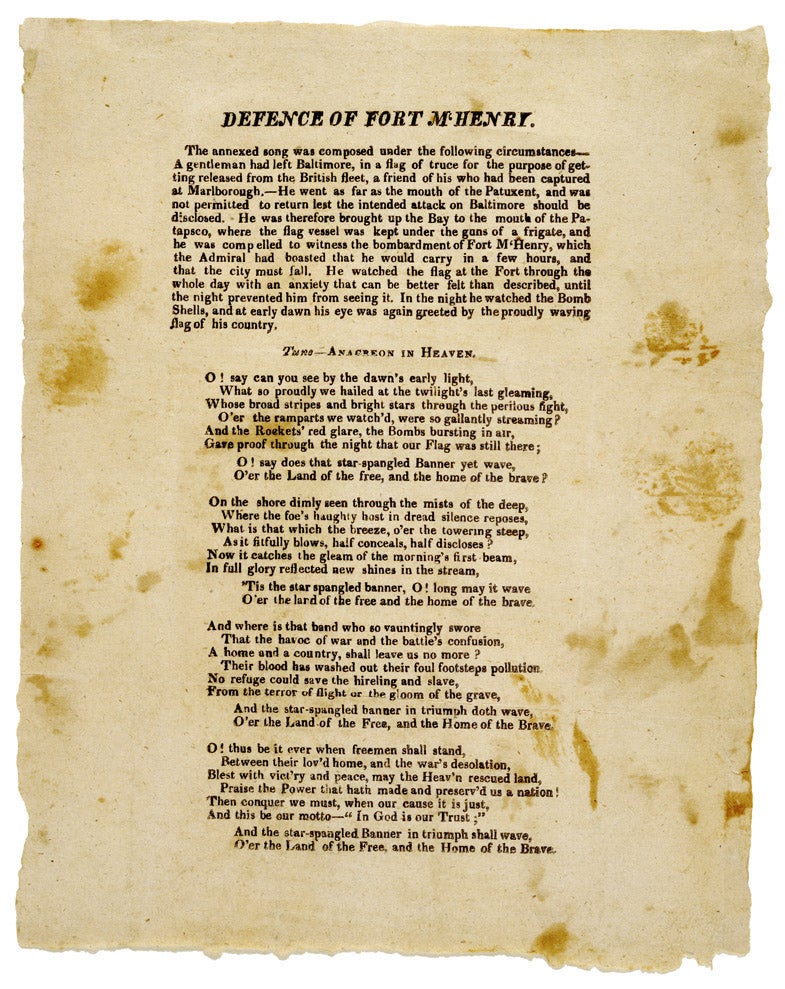
“The Star-Spangled Banner,”
originally “Defence of Fort McHenry”
by Francis Scott Key (1779–1843)
written Sept. 14–16, 1814
Tune: “Anacreon in Heaven”
O! say can you see by the dawn’s early light,
What so proudly we hailed at the twilight’s last gleaming,
Whose broad stripes and bright stars through the perilous fight,
O’er the ramparts we watch’d, were so gallantly streaming?
And the rockets’ red glare, the bombs bursting in air,
Gave proof through the night that our flag was still there;
O! say does that star-spangled banner yet wave,
O’er the land of the free, and the home of the brave?
On the shore dimly seen through the mists of the deep,
Where the foe’s haughty host in dread silence reposes,
What is that which the breeze, o’er the towering steep,
As it fitfully blows, half conceals, half discloses?
Now it catches the gleam of the morning’s first beam,
In full glory reflected now shines in the stream,
‘Tis the star-spangled banner, O! long may it wave
O’er the land of the free, and the home of the brave.
And where is that band who so vauntingly swore
That the havoc of war and the battle’s confusion,
A home and a country, shall leave us no more?
Their blood has washed out their foul footsteps’ pollution.
No refuge could save the hireling and slave,
From the terror of flight, or the gloom of the grave,
And the star-spangled banner in triumph doth wave,
O’er the land of the free, and the home of the brave.
O! thus be it ever, when freemen shall stand
Between their lov’d home and the war’s desolation,
Blest with vict’ry and peace, may the Heav’n rescued land
Praise the Power that hath made and preserved us a nation!
Then conquer we must, when our cause it is just,
And this be our motto: “In God is our trust;”
And the star-spangled banner in triumph shall wave
O’er the land of the free, and the home of the brave.
COMMENTARY
Note this text is a regularized transcription of the first 1814 broadside printing of Key’s song (pictured). Three corrections have been made: verse 2, line 6, change e to o to read “now”; adding a hyphen in line 7 of the same verse, and in verse 3, line 4, adding apostrophe to make “footsteps” possessive.
“O“—Often this word is mistaken for “Oh,” which is an entirely different word. “O” alone is an exclamation in the vocative case.
“glare, air, there“—this triple rhyme is unique and characteristic of lyrics written to the tune of “The Anacreontic Song” and gives its eight-line stanzas a total of nine rhymes each.
Chorus—the final two lines of each verse form the chorus of the musical form and were initially sung twice—first by a soloist and then re-echoed back by the audience. This practice ceased in the twentieth century when the anthem was often sung by groups instead of a soloist.
“?“—it is easy to miss, but the first verse of the U.S. national anthem asks a question. This can be seen not just as symbolic, but as a call to action to serve the nation. No other national anthem asks a question.
“hireling and slave“—this troubling phrase most likely was understood to refer to the British enemy, who were both paid mercenaries and vassals of King George III. Here the author contrasts the enemy with heroic American militiamen who fought as volunteers of their own free will. See the book O Say Can You Hear?, pages 187–195, for a fuller discussion. There I argue that the shift to singular here is important and that Key’s vitriol was most specifically directed at British Major General Robert Ross.

